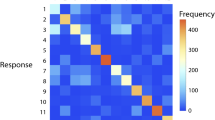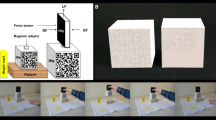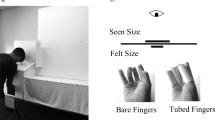Abstract.
With visual input blocked, subjects in this study utilized fingertips only to investigate the involvement of haptically perceived size in heaviness perception among humans. The objects used for testing consisted of three sets – copper (CP), aluminum (AL), and plastic (PL) – of ten cubes of various weights (0.05–0.98 N). All of the cubes were covered with a smooth vinyl material to eliminate any extraneous input concerning the actual composition. Screens enclosed the working space to eliminate any possible visual cues. Each comparison was between a pair of cubes of the same material to eliminate the effect of density. Fifteen subjects (M=19.2, SD=0.68 years) attempted to judge differences in heaviness between the first and second cube in each trial that had been handed to them by the experimenter and were grasped between the thumb and the index finger. A total of 340 trials with 70 combinations of weight composed of 160 ascending trials (heavier), 160 descending trials (lighter), and 20 identical weight trials were pseudo-randomly presented to each subject for each material. Combinations of difference in weight and the number of trials were identical for all materials so that haptic size was regarded as the single independent factor. Accuracy of the subjects' responses for identical weight differences that resulted from placing a pair of cubes of the same combination was compared among the three materials. It was observed that a material like CP that had a lesser size effect facilitated significantly more accurate discrimination of the identical weight differences than PL with its greater size effect. This suggests that small changes in haptic size by the fingertips have a direct influence on heaviness perception when comparing objects of equal density. This finding, therefore, can be considered analogous to the size-weight illusion when comparing objects of unequal density. The findings of this study also suggest the constant involvement of haptic size in heaviness perception by humans along with the existence of a processing mechanism that integrates the factors of weight and haptic size in which heaviness increases either as weight increases or as size decreases, and vice versa.
Similar content being viewed by others
Author information
Authors and Affiliations
Additional information
Electronic Publication
Rights and permissions
About this article
Cite this article
Kawai, S. Heaviness perception. Exp Brain Res 147, 16–22 (2002). https://doi.org/10.1007/s00221-002-1209-3
Received:
Accepted:
Issue Date:
DOI: https://doi.org/10.1007/s00221-002-1209-3




